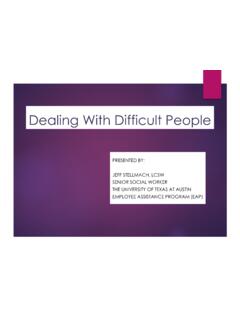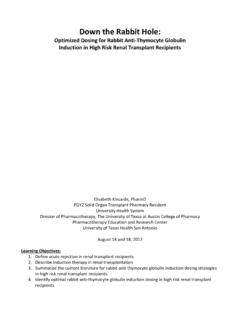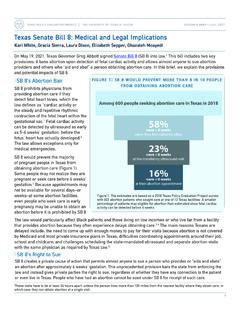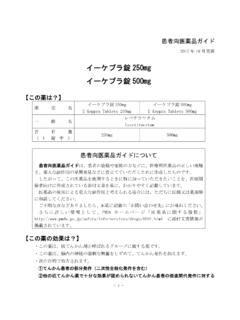Transcription of Seizure Prophylaxis in Traumatic Brain Injury
1 Seizure Prophylaxis in Traumatic Brain Injury Alison Merkel, PharmD. PGY-1 Pharmacy Resident, St. David's South Austin Medical Center The University of Texas at Austin College of Pharmacy Pharmacotherapy Rounds October 23rd, 2015. Objectives Describe the pathophysiology of seizures in Traumatic Brain Injury Review the mechanism of action and adverse effects associated with phenytoin and levetiracetam Compare and contrast outcomes associated with antiepileptic use in Traumatic Brain Injury Develop a recommendation for Seizure Prophylaxis in Traumatic Brain Injury patients Introduction _____. I. Epidemiology of Traumatic Brain Injury1. Figure 1. Epidemiology of Traumatic Brain Injury Million ED Visits 275,000 Admissions 1 in 10 patients will have a Seizure 52,000. Deaths a. Definition: Any blunt force trauma to the Brain b. Leading Causes a. Falls b. MVA. c. Assaults d. Gunshot wounds e. Explosions c.
2 Demographic Incidence a. Male b. Children 0-4yo, Adolescents 15-19yo, Elderly >65yo II. Post- Traumatic Seizures (PTS) Figure 2. Seizure Pathophysiology a. Pathophysiology Sudden, abnormal electrical disturbance in the brain3. i. Inhibitory - GABA. 1. Cl- Influx ii. Excitatory 1. Na+ influx 2. Ca2+ influx 3. K+ efflux iii. Etiology4. 1. Physical insult 2. Neural tissue damage 3. Cortical lesions II. Post- Traumatic Seizures (cont.). b. Incidence5,6. i. Early PTS 4-25%. 1. 50% within the first 24 hours 2. 25% within the first hour 3. 29-fold increased risk of developing epilepsy ii. Late PTS 9-42%. 1. 25% of patients with early PTS will have another Seizure 2. No benefit of PHE to prevent late PTS. III. Detection of Early Seizures4. a. Clinical i. Within 24 hours 1. Tonic - Jerking, shaking 2. Clonic - Muscle rigidity, loss of motor control ii. 24h - 7days 1. Focal - Staring spells b. Electrical i.
3 Electroencephalograph7. 1. Shows abnormality in over 80% of epileptic patients 2. Does not predict the risk of epilepsy or type of Seizure c. TBI and Neuromuscular blockers can mask clinical signs & symptoms of early PTS. i. Incidence of clinical seizures around 10%, can increase to 50% when diagnosed by EEG8. IV. TBI Assessment a. Glasgow Coma Scale(See Appendix A)9. i. 15 point scale used to describe a patients level of consciousness ii. Scoring Categories 1. Eye 2. Verbal 3. Motor iii. Severity of TBI. 1. Mild: 13-15 points 2. Moderate: 9-12 points 3. Severe: 3-8 points b. Glasgow Outcome Scale10. i. 5 (GOS) or 8 (GOS-E) point scoring system to assess how Injury has affected functioning c. Glasgow Outcome Scale (cont.). i. Categories 1. Consciousness 2. Independence inside and outside the home 3. Work 4. Social/Leisure Activity 5. Family and Friendships 6. Return to normal life ii. Scoring System 1.
4 Death 2. Vegetative State 3. Severe Disability Further classified into upper 4. Moderate Disability and lower on Extended GOS. 5. Good Recovery V. Risk Factors for PTS11. a. Early i. Amnesia >30-24h minutes ii. Age <65. b. Late i. Amnesia >24h ii. Age <65. c. Early and Late i. Depressed skull fractures ii. Intracerebral or subdural hematoma iii. Penetrating head Injury iv. GCS 3-8. v. No/brief unconsciousness VI. Current Guidelines a. American Academy of Neurology (AAN) 20031. i. Prophylactic treatment with phenytoin as soon as possible ii. Prophylaxis NOT routinely used after 7 days b. Brian Trauma Foundation 20077. i. Phenytoin shown to reduce incidence of early PTS. ii. Valproate has comparable effects but higher mortality iii. Seizure Prophylaxis >1 week after TBI not recommended Early Post- Traumatic Seizure Prophylaxis Timeline _____. VII. Early PTS Prophylaxis a. Carbamazepine12. Table 1.
5 Outcomes Associated With Carbamazepine For Seizure Prophylaxis in Severe TBI. Population Intervention Outcome Results Glotzner >15yo,mod to CAR (n=75): 100mg TID titrated Placebo Early PTS p< , RR = et. al sev TBI to therapeutic level of 300- (n=76). 198312 n=151 600mcg/mL for years i. Bottom Line 1. Significantly lower incidence of early; No difference in late seizures 2. Patients were initially treated with PHE 750mg LD then 250-500mg daily until they could receive PO carbamazepine b. Phenytoin Table 1. Outcomes Associated With Phenytoin For Seizure Prophylaxis in Severe TBI. Population Intervention Outcome Results Young et. >15yo, Blunt or PHE (n=136): 11 mg/kg LD Placebo Early PTS 5 ( ) vs. 5 ( ). al 198313 penetrating TBI 13 mg/kg IM daily x 7 days (n=108) p= n=244. Temkin Severe TBI PHE (n=208): 20mg/kg LD Placebo Early PTS vs. et. al n=404 IV or PO MD adjusted to (n=198) p< , RR= 199014 achieve level of 10-20 [95% CI ].
6 Haltiner Severe TBI PHE 20mg/kg LD Placebo Mortality p= et. al n=404 IV or PO MD adjusted to Hypersensitivity p= 199915 achieve level of 10-20 x 12 mo Mortality in early p= PTS. i. Bottom Line 1. Significantly lower risk of ePTS with PHE use (37% Risk reduction). 2. No difference in hypersensitivity or mortality with PHE compared to placebo a. Significantly higher mortality in patients that suffered ePTS. 3. Monitoring a. 97% of PHE patients had levels in or above therapeutic range on the first day after Injury , and 57% were maintained at 1 week in pooled analysis of Temkin and Haltiner studies1. VII. Early PTS Prophylaxis (cont). c. Valproate Table 3. Outcomes Associated With Valproate For Seizure Prophylaxis in Severe TBI. Population Intervention Outcome Results Temkin et. 14 yo , TBI, LD PHE: 20mg/kg LD, Occurrence of late p= , RR = al 199916 administered 5mg/kg/d MD x 1 wk seizures [95% CI ].
7 W/in 24 hours of VPA: 20mg/kg LD, Occurrence of early p= , RR = admission 15mg/kg/d x 1 mo seizures [95% CI ]. (n=379) VPA: 20mg/kg LD, 15mg/kg/d x 6 mo Mortality p= , RR= [95% CI ]. Dimken et. --------------- -------------------- Neuropsych capability at p values: al 200017 1, 6, and 12 months i. Bottom Line 1. No significant difference in rates of early PTS between VPA and PHE. 2. No difference in long-term neuropsychological or cognitive measures 3. Trend towards greater mortality with VPA. a. VPA not recommended due to limited data Phenytoin and Levetiracetam _____. VIII. Phenytoin18. a. Mechanism of Action i. Promotes sodium efflux from neurons; stabilizes threshold b. Dosing i. LD: 15-20mg/kg, md: 300-600mg/day, divided in 3 doses c. Monitoring21. i. Goal: 10-20mcg/mL. 1. Draw level 2-3 after LD; Can draw 2 hours after IV LD to aid dosing 2. Need to adjust for low serum albumin: AdjPHE = TotalPHE/[( x alb) + ].
8 Ii. Slow absorption, peaks usually reached in 4-8 hours iii. Steady State reached in 5-10 days 1. Best trial data monitored levels 3x/week iv. Factors that can alter levels: CYP inducers and inhibitors, age, albumin, alcohol use, liver disease, uremia, drug displacement 22,23. d. Adverse Effects i. Hypersensitivity reactions (DRESS). ii. Stevens-Johnson syndrome iii. Hepatotoxicity iv. Hematopoietic complications v. Purple glove syndrome vi. IV Administration 1. 50mg/min 2. Cardiovascular complications IX. Levetiracetam19. a. Mechanism of Action i. Exact mechanism unknown; Possible involvement of Ca2+ channels and SV2A protein b. Dosing i. LD: 1,500-2,000mg IV infused over 15 minutes(off-label). ii. MD: 500mg daily, titrate to 1,500mg BID. c. Monitoring i. Not required in acute treatment d. Adverse Effects i. Behavioral problems ii. Coordination Difficulties iii. Drowsiness/somnolence Figure 3.
9 Phenytoin and levetiracetam mechanism of action Levetiracetam SV2A. Phenytoin X. Physician Preference (See Appendix B)24. a. Q-PULSE panel i. Epilepsy specialists from National Association of Epilepsy Centers (NAEC). b. Medication preference i. 74% Levetiracetam ii. 10% Phenytoin c. Impact on decision i. 86% of physicians report scientific data as having substantial impact on decision ii. 86% of physicians report personal experience having substantial impact on decision Phenytoin vs. Levetiracetam - Literature Review _____. Table 4. Jones KE, Puccio AM, Harshman KJ et. al. Levetiracetam versus phenytoin for Seizure Prophylaxis in severe Traumatic Brain Injury . Neoursurg Focus. 2008; 25(4): Purpose Evaluate the occurrence of early posttraumatic Seizure activity based on EEG. findings in patients receiving phenytoin versus those receiving levetiracetam Design Prospective cohort, single-center, double-blind Population Inclusion: Severe TBI, defined as GCS 3-8, administration of AED within 24 hours of admission, patient had an EEG examination, Prophylaxis for 7 days Exclusion: Not defined Intervention LEV: LD 500mg IV Q12H x 7 days PHE: Not defined cases pulled from severe TBI data base cEEG initiated and continued for 72 hours PHE levels check on days 2 & 7, doses adjusted by one designated study pharmacist to maintain level between 10-20 mcg/dL.
10 Patients with seizures on MAX dose of treatment would receive opposite therapy in addition to original AED assigned o Max MD doses defined as 1500mg BID LEV or 20mcg/dL level of PHE. Outcomes Primary Secondary Abnormal EEG findings Glasgow Outcome Scale at 3 and 6. o Status epilepticus months o Seizure activity o Seizure tendency Statistical Fisher's exact tests for comparison of categorical variables Analyses Chi-squared and Mann-Whitney U-tests for comparison of continuous variables Results Total (n = 27); LEV (n = 15), PHE (n = 12). Demographics No significant difference baseline characteristics or GCS score Primary Outcome Significant difference between occurrence of abnormal EEG findings in LEV vs PHE (53% vs 0%, p= ) and Seizure tendency (47% vs. 0%, p= ). No difference in Seizure activity (1% vs 0%, p= ). Secondary Outcomes No difference in GOSE scores at 3 or 6 months (p= , p= ). Conclusions No significant difference in occurrence of early seizures Further prospective studies should include EEG monitoring to obtain the most accurate results Critique Small sample size - Study not powered to detect outcome differences Higher percentage of LEV patients required EEG monitoring due to coma, change in mental status, or clinical Seizure activity Unclear if EEGs were assessed by the same neurologist potential for bias No information on PHE dosing or serum levels Table 5.











